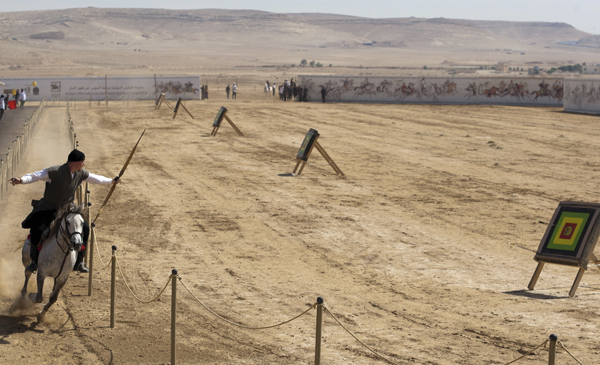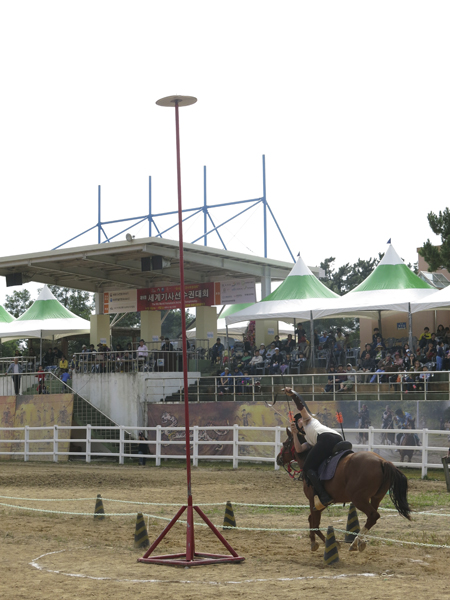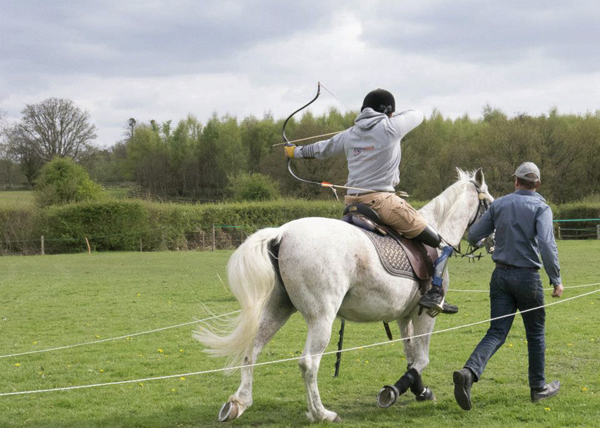Dan Sawyer of the British Horseback Archery Association gives you an overview of this unique side of the sport: how it used to be, how it’s practiced now, and how you can get involved
The centaur is one of the most iconic figures in all of mythology. Half man, half horse, he was typically armed with a bow and symbolised the wild part of human nature. What led the Greeks to invent this creature? In all likelihood it was their encounters with the Scythians, a tribe of Steppe nomads from the north, who rode their horses into battle, shooting their bows with deadly accuracy and speed. The terrifying image was one that would menace western civilisations for centuries as European armies suffered at the hands of the Parthians, Huns, Avars, Mongols, Turks and others. Rather later, American armies would receive the same shock all over again when Comanche warriors would gallop into battle shooting their bows faster than the US forces could reload their weapons. The art was also practised in Britain. References to it are rare but undeniable: William the Conqueror was described as being able to draw his bow (which no other man could pull) at full gallop and there are depictions of horseback archers in works as diverse as prayer books and chronicles of the 100 Years’ War.
At the same time, but largely unknown to westerners, the people of Manchuria, China, Korea and Japan all developed traditions of horseback archery. In Japan the art is considered a form of worship and has a continuous history spanning 3,000 years. In Korea, horseback archery remained a requirement for army officer qualification until the 20th century.
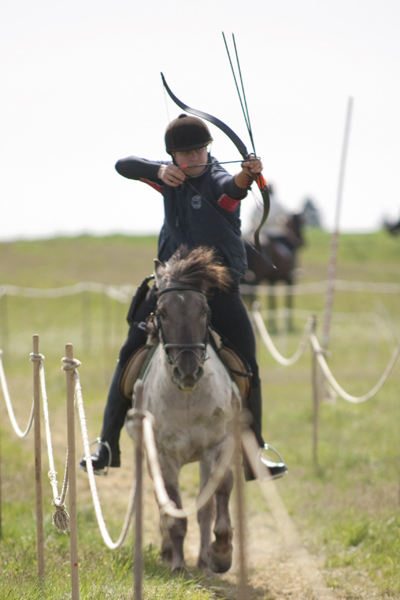
The author holding multiple arrows for rapid reloading during the Hungarian event at the first stage of the European Grand Prix in Poland, 2014
Today, horseback archery is a fast-moving and fast-growing sport with competitors from six continents regularly competing around the world. There are various disciplines, ranging from the standard Korean and Hungarian (riding along a track shooting forwards, sideways and backwards at known distances) to qabaq (a traditional Turkish event which involves twisting and bending in the saddle to shoot straight upwards at a target on top of a pole) and Polish (a cross-country event with targets at varying angles, ranges and sizes). For the really courageous there is also mogu, in which one rider gallops along a wide track, dragging an uneven cloth ball behind them while two others chase them and attempt to shoot the ball with blunts dipped in ink.
All shooting is off the knuckle, using either the Mediterranean or thumb draw, employing a wide variety of bow, ranging from the short “horsebow” to the English longbow and the even longer Japanese yumi. Since most shooting is at close range, there are competitors using fairly basic £150 bows. As the sport grows, however, more bowyers are taking notice and at the top of the sport the classic Saluki bows are being joined by newer bows such as Anton de Wit’s Meerkat and the ultra-modern Border Ghillie Dhu.
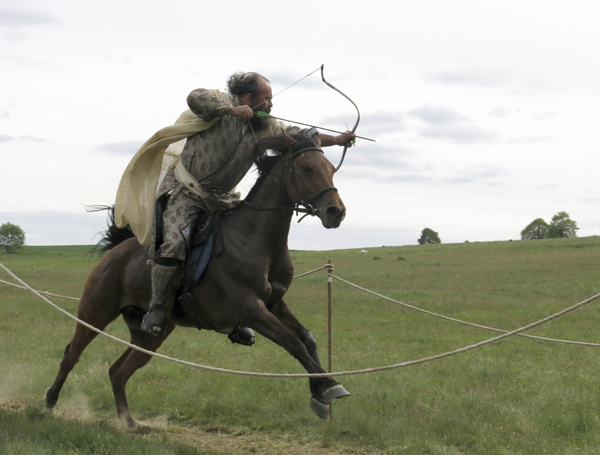
Ali Goorchian, from the Persian Horseback Archery Association, in traditional dress. Ali is a former World Champion and has carried out extensive research into historical techniques used by the ancient Persian horseback archers
Speed of shooting is of the essence: there are bonus points for shooting faster, and at the upper levels of the sport shooting one arrow every three seconds is considered a bare minimum. Many people shoot much faster. Nocking and aiming at that rate is hard enough on firm ground, doing it while riding faster than Usain Bolt runs requires hours of training, even before accuracy is considered. As you might expect, much thought goes into devising quicker and more efficient methods of nocking and drawing, either from a quiver (required in some disciplines) or in the hand (some competitors hold over a dozen arrows in their bow hand).
While this is a far cry from re-enactment, there remains a considerable focus on the history of the sport. As well as research into historical techniques, traditional dress is encouraged at many events, which can lead to a veritable pageant of finery, from the highly decorated flowing silk robes of the Japanese and Koreans to the more earthy, homespun garb of the Steppe. One or two even compete in armour, including mail coat and helmet, generally complete with a sword and sometimes wielding bows of 90lbs or more. More commonly, competitors wear either a polo shirt or some form of kaftan or robe. Few competitions specify a dress code (in Britain, competitors are free to wear whatever suits them). Nonetheless, this is a sport that is high on spectacle.
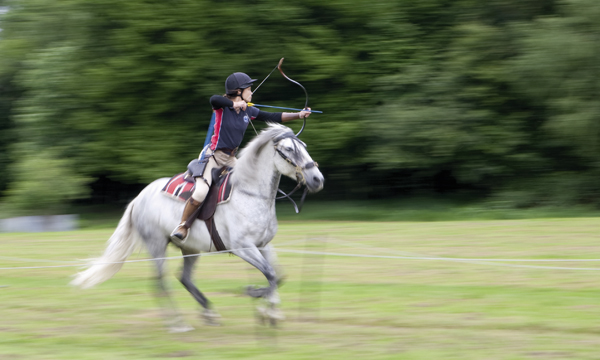
Claire Sawyer, President of the International Horseback Archery Alliance, maintaining a steady shot at speed at the Centre of Horseback Combat, 2013
Most international horseback archery events are run in an Open format – individuals attend and compete on their own behalf, albeit representing their countries (in much the same way as professional golf and tennis are run). Britain is at the forefront of a move towards more team-orientated events, although our members do attend the Opens as well. For example, GB are currently competing in the European Grand Prix Series, in which teams from various nations compete in three separate stages, each in a different country, with points accrued for finishing positions. As I write, Britain lie second in this event, following great success in Poland in early May 2014. Two of the team from that event have been doing the sport for less than two years, showing the effectiveness of our development program: of the nine people likely to represent GB this year, only three have been competing for more than three years.
In an echo of the original military use of horseback archery, the sport is now being used to help in the rehabilitation of servicemen and women suffering from physical or psychological injuries. The charity HorseBack UK in the Cairngorms has a long and successful history of using equestrianism as a form of therapy and now, after a little help from the BHAA, horseback archery is being used to aid the recovery of those injured in service.
The British Horseback Archery Association exists to further the sport in this country and abroad. We are affiliated to the World Horseback Archery Federation and the International Horseback Archery Federation, and members of the BHAA Committee are officers in both of these international bodies. As well as running coaching sessions, using both domestic and overseas coaches, the BHAA organises the national championships and the BHAA International Series, a unique initiative in which other countries send teams to Britain to compete in matches against Team GB and a GB Development Team. Our members are also active in competition abroad and we have among our ranks a former world silver medallist and two former world bronze medallists. We can be found on Facebook or via the website www.bhaa.org.uk.
It has never been easier to get involved in horseback archery. The Centre of Horseback Combat in Hemel Hempstead (www.horsebackcombat.co.uk) runs regular beginners’ sessions, and experience days. No previous riding – or archery – experience is necessary and they provide not just superbly trained horses but also all the kit you need for the day. Once you are comfortable riding and shooting at a canter the BHAA’s own training sessions, competitions and grading system (similar to GNAS classifications) are open to you, along with a world of opportunities here and abroad.


